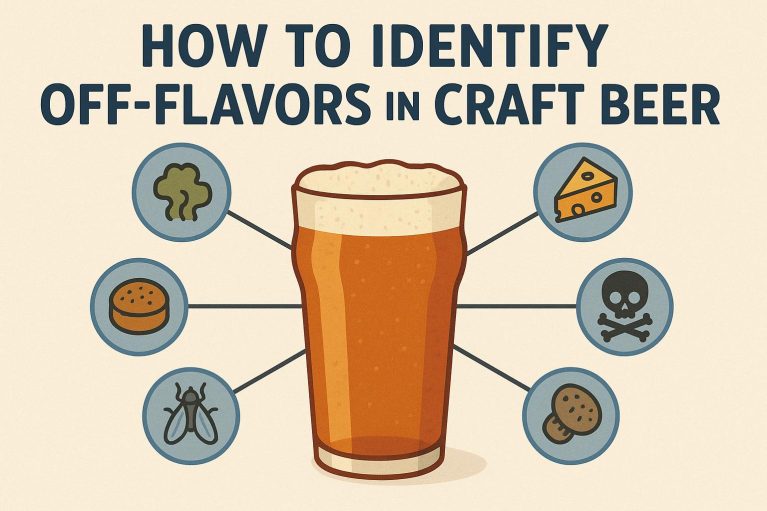Introduction to Off-Flavors in Craft Beer
Craft beer has gained popularity among both casual drinkers and dedicated enthusiasts for its vast spectrum of flavors and styles. While the best craft beers offer a harmonious blend of ingredients, sometimes unintended flavors creep into the brew. These off-flavors can detract from the overall experience. Recognizing and understanding these off-flavors is essential for homebrewers striving for perfection and connoisseurs aiming to refine their tasting skills.
Common Off-Flavors and Their Causes
A broad understanding of off-flavors begins with identifying the most prevalent ones in craft beer. These undesirable tastes often arise due to various factors, including brewing errors, unwanted chemical reactions, contamination, or problems with the brewing ingredients themselves. The proficiency in recognizing these flavors aids in diagnosing issues and refining the brewing process.
Diacetyl
Diacetyl is a compound notorious for imparting a noticeable buttery or butterscotch flavor. Its presence is generally unwanted unless in specific styles where it is a traditional flavor component. Diacetyl is produced during fermentation, primarily as a byproduct of yeast activity. To manage diacetyl levels, brewers often employ a “diacetyl rest,” a stage where the temperature is slightly elevated towards the end of fermentation, allowing yeast to naturally reduce its concentration. This step is crucial for ensuring a crisp, clean finish in many beer styles.
Acetaldehyde
Another common off-flavor is acetaldehyde, which gives the beer an aroma similar to green apples or freshly cut pumpkins. In most cases, its presence is a clear indication of incomplete fermentation. Acetaldehyde is a natural intermediate compound in the transformation of sugar to alcohol, and when yeast metabolism is arrested early or yeast cells are stressed, higher levels can persist in the beer. To mitigate this, brewers should ensure their fermentation processes allow ample time for yeast to complete the conversion of acetaldehyde to ethanol, focusing also on maintaining yeast health and activity through proper nutrition and conditioning.
Phenolic
Phenolic flavors in beers are often described using terms like clove, medicinal, or band-aid. These flavors, in general, result from the presence of certain phenolic compounds, which may be produced by wild yeast or specific strains of brewing yeast, such as those used for wheat beers. While phenolic flavors are desired in certain beer styles, they are considered off-flavors in many others. Achieving proper sanitation during the brewing process and using high-quality, style-appropriate yeast strains can significantly reduce the occurrence of unwanted phenolic flavors.
Oxidation
Oxidation is a condition that typically results in flavors akin to cardboard or stale beer, generally viewed as a sign of poor brewing or storage practices. This off-flavor occurs when the beer is exposed to oxygen either during the brewing or packaging process. The adverse effects of oxidation become more noticeable as the beer ages, leading to a dulling of its fresh, vibrant flavors. Brewers can avoid these issues by minimizing oxygen contact when transferring the beer from one vessel to another and during bottling or kegging.
Methods for Detecting Off-Flavors
For those serious about mastering craft beer, detecting off-flavors efficiently requires a combination of training sensory skills and understanding potential brewing faults. Two major methods are commonly utilized:
Sensory Analysis
Undertaking systematic sensory analysis sessions is an effective way to train the palate to recognize off-flavors. This involves structured tasting exercises where the focus is on identifying specific sensory attributes against the expected profile of a well-crafted beer. Over time, this practice enhances not only one’s recognition of off-flavors but also deepens the understanding of the beer’s overall flavor complexities, allowing tasters to pinpoint subtle inconsistencies or undesirable notes.
Utilize Off-Flavor Kits
Off-flavor kits are practical tools for both beginners and seasoned brewers to hone their ability to detect specific off-flavors. These kits typically include samples that simulate a particular off-flavor scenario by adding controlled amounts of specific compounds to base beer. Practicing with these kits allows brewers and enthusiasts to calibrate their sensory perception and address brewing errors effectively. It also helps build confidence in distinguishing nuanced flavor differences during sensory evaluation.
Conclusion
In conclusion, knowledge and detection of off-flavors are integral skills for anyone involved in the craft beer scene, whether brewing at home or evaluating commercial offerings. By familiarizing themselves with common off-flavors and implementing methods such as sensory analysis and utilizing off-flavor kits, individuals can significantly enhance both their tasting acumen and brewing prowess. For those invested in furthering their brewing competencies, diverse resources and educational platforms are available, promising a satisfying journey toward brewing excellence and greater appreciation of this storied craft.

